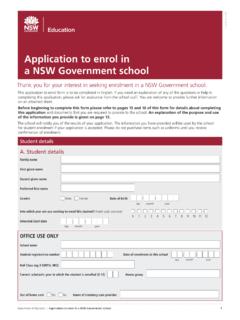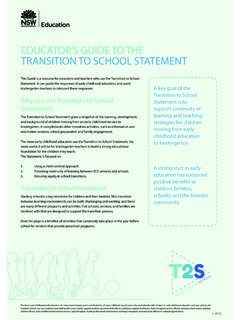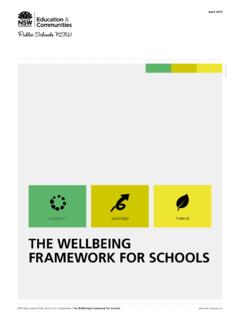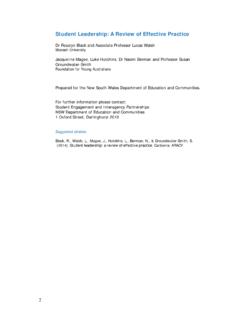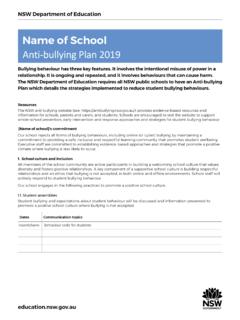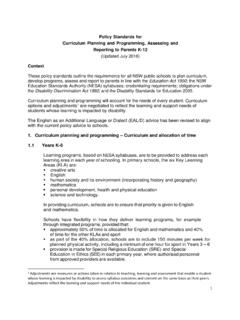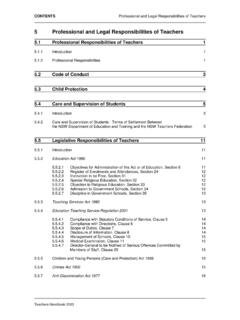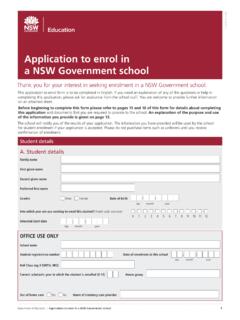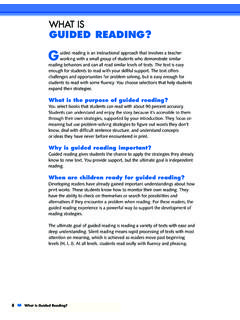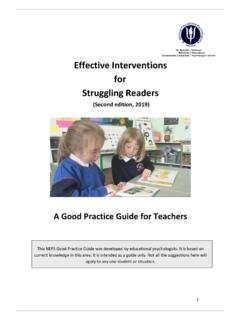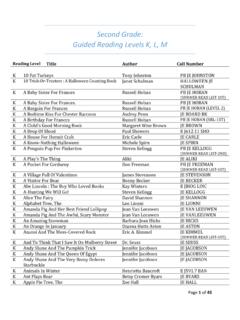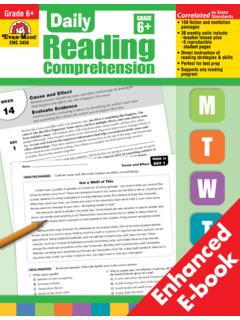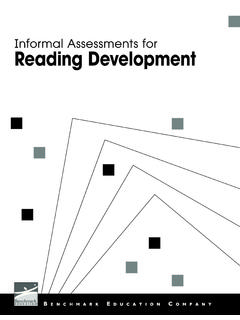Transcription of Stage 1 Reading: Inference
1 | NSW Department of Education Literacy and Numeracy Teaching Strategies - reading Inference Stage 1. Overview Learning intention Students will learn what it means to infer. They will learn to make and explain inferences by using background knowledge and clues in the text. Syllabus outcome The following teaching and learning strategy will assist in covering elements of the following outcome/s: EN1-4A draws on an increasing range of skills and strategies to fluently read, view and comprehend a range of texts on less familiar topics in different media and technologies Success criteria The following suggestions may guide teachers to develop success criteria for student learning.
2 Explains what infer' and Inference ' mean infers meaning by using background knowledge and evidence in text explains inferences made from sounds, objects, images, sentences and text. National Literacy Learning Progression guide Understanding texts (UnT4-UnT6). Key: C=comprehension P=process V=vocabulary UnT4. makes predictions (uses the cover of a book or screen image to predict the content) (C). makes connections between texts and personal experiences (C). makes relevant comments or asks relevant questions to demonstrate understanding of the text (C). UnT5. views and discusses the content and features of texts with predictable structures (identifies new or learnt information after reading ) (C).
3 Infers meaning by integrating print, visual and audio aspects of simple texts (C). UnT6. draws inferences and explains using background knowledge or text features (infers feelings character's feelings from actions) (C). identifies parts of text used to answer literal and inferential questions (P). Teaching and learning experiences Resources What is Inference ? Appendix 1 Inference equation Exit slip What is an Inference ? Appendix 2 Blank Inference equation Inferring meaning from objects Appendix 1 Inference equation A range of familiar objects such as sunscreen, googles, toy spade, a water bottle, a soccer ball, and a child's hat.
4 Exit slip How do I make inferences based on objects? Inferring meaning from images Appendix 1 Inference equation Appendix 3 Image Appendix 4 Shoes Appendix 5 A range of images Appendix 6 Inferring from images Inferring meaning from a sentence Appendix 1 Inference equation Appendix 7 Inferring with sentences Inferring meaning from a group of sentences Appendix 1 Inference equation Appendix 2 Blank Inference equation Appendix 8 Making an Inference from a group of sentences Inferring meaning from a text extract Appendix 9 George's Marvellous medicine Appendix 10 Little leaf boat Appendix 11 - Inferring from texts
5 Independently 2 Stage 1 reading : Inference Background knowledge Inferential comprehension Inferential comprehension is the ability to process information and understand the underlying and unstated meaning. This information is then used to infer or determine deeper meaning that is not explicitly stated. In relation to texts, inferential comprehension requires viewers and readers to: combine ideas draw conclusions interpret and evaluate information identify tone and voice. A higher and more complex level of comprehension involves critical analysis which requires readers to: be critical form opinions identify authors' points of view and attitudes identify and consider the authority of texts and their messages infer motives of characters and themes.
6 It is important to remember that students come to us with a wide variety of experiences and it is essential to not assume they have particular background knowledge. EAL/D learners in particular may not share the background knowledge of their peers who grew up in Australia and may understand experiences and events according to their first culture. Where to next? Audience and purpose Reference list ACARA (2018). National Literacy Learning Progression Centre for Education Statistics and Evaluation (2017). Effective reading instruction in the early years of school, research report.
7 Centre for Education Statistics and Evaluation (2020). What works best: 2020 update. Dahl, R. (1981) George's marvellous medicine. Jonathan Cape, UK. English K-10 Syllabus 2012 NSW Education Standards Authority (NESA) for and on behalf of the Crown in right of the State of New South Wales. NSW Department of Education, Apr-21 3. Effective reading instruction in the early years of school The CESE literature review Effective reading Instruction in the Early Years of School (2017) outlines the key components of effective reading instruction. The research base has been furthered explored in the Effective reading guide which outlines the Simple View of reading and Scarborough's reading Rope.
8 Comprehension is an active process that involves the reader understanding and interpreting what is read. It is heavily dependent on a student's word recognition skills and their language comprehension abilities. To be able to understand written material, students need to be able to first decode what they read and then apply their language comprehension to make connections between what they read and what they already know. In the context of effective reading instruction for the early years, it is important to understand that while students are learning the alphabetic code the majority of comprehension instruction should focus on oral language comprehension development through explicit teaching during modelled and shared reading experiences.
9 An explicit focus on teaching students to strategically apply their background knowledge, vocabulary knowledge, knowledge about texts, understanding of language structures and reasoning skills to texts will support them to develop strong language comprehension abilities as they develop fluent word recognition skills. What works best - Explicit teaching Explicit teaching practices involve teachers clearly explaining to students why they are learning something, how it connects to what they already know, what they are expected to do, how to do it and what it looks like when they have succeeded.
10 Students are given opportunities and time to check their understanding, ask questions and receive clear, effective feedback. This resource reflects the latest evidence base and can be used by teachers as they plan for explicit teaching. Teachers can use assessment information to make decisions about when and how they use this resource as they design teaching and learning sequences to meet the learning needs of their students. Further support with What works best is available on the What works best website. Gradual release of responsibility model The Gradual release of responsibility model is a helpful framework to understand what explicit instruction can look like when teaching reading .
